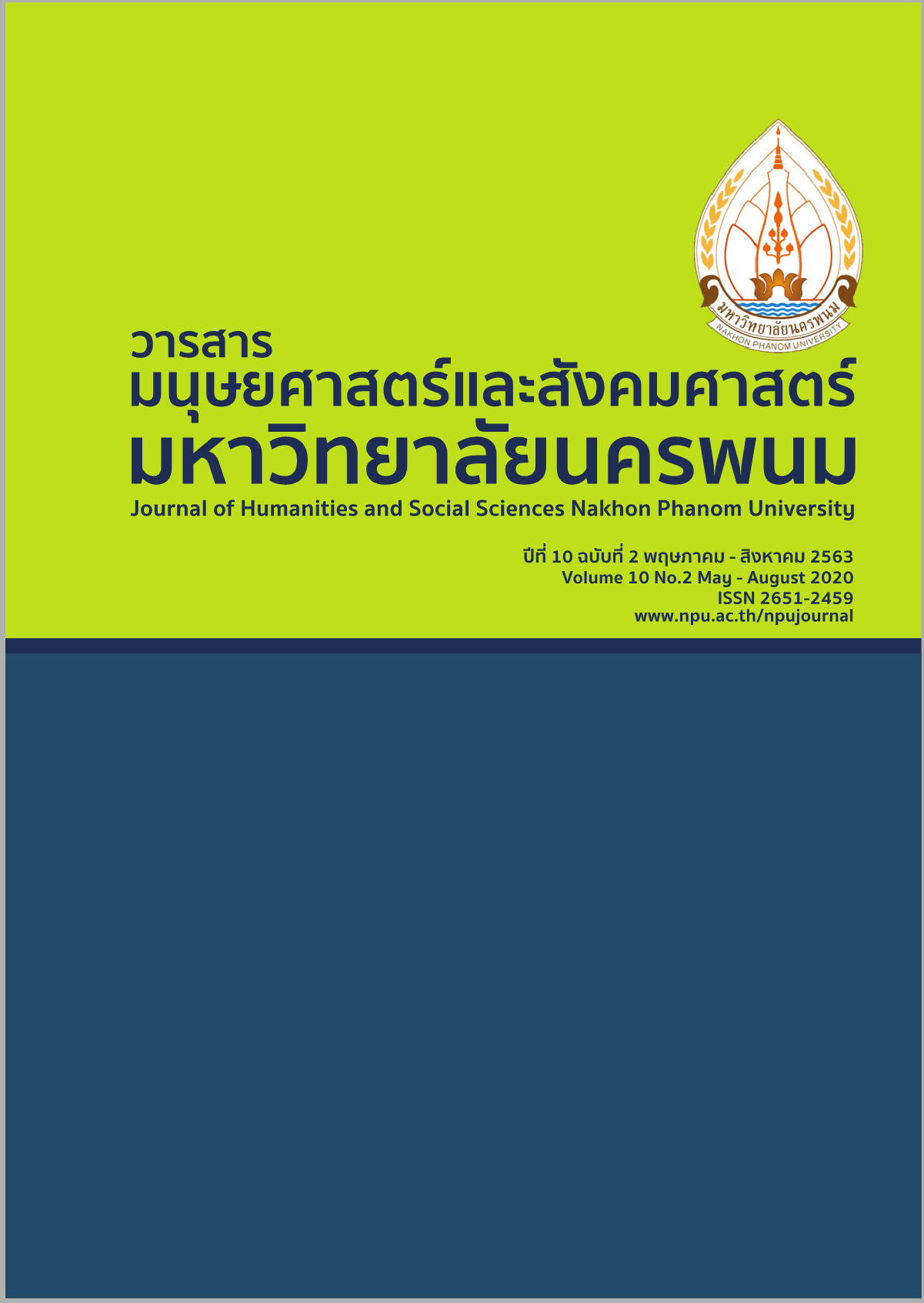The Faces of Teens: The Exhibition of Multiple-identity in Social Media
Main Article Content
Abstract
Based on the social identity theory this paper investigates the development of multiple-identity of Thai teens when engaging in social media. Although the continuum of behaviors from interpersonal to intergroup remains unchanged in both online and offline sphere, this article hypothesizes that social media offers more options for individuals to manage the development and the deployment of their identities. Hidden within the unfathomed and far-reaching space of social media are myriad of fragmented channels in which one can freely choose. Engagement in social media therefore has become more complicated and leads to the development of social identity complexity and multiple-identity of teenagers. Sixteen focus group sessions with 101 participants, aged 16-18 years old. Findings from this study reveal the exhibition of multiple identities of teens in different social media account for different purposes. While the exhibition of multiple-identity can be one’s personal fulfillment, inner frustrations are controversial.
Key words: multiple-identity, teenager, social media, identity formation
Article Details
References
Baruh, L. (2010). Mediated voyeurism and the guilty pleasure of consuming reality television. Media Psychology, 13(3), 201-221.
Boyd, D. (2014). It's complicated: The social lives of networked teens: Yale University Press.
Boyd, D., & Ellison, N. (2007). Social network sites: Definition, history, and scholarship. Journal of computer‐mediated Communication, 13(1), 210-230.
Brewer, M., & Pickett, C. (2014). Distinctiveness motives as a source of the social self. In The psychology of the social self (pp. 79-96): Psychology Press.
Cheng, Z., & Guo, T. (2015). The formation of social identity and self-identity based on knowledge contribution in virtual communities: An inductive route model. Computers in Human Behavior, 43, 229-241.
Cheung, C., & Lee, M. (2010). A theoretical model of intentional social action in online social networks. Decision support systems, 49(1), 24-30.
Crocetti, E. (2017). Identity formation in adolescence: The dynamic of forming and consolidating identity commitments. Child Development Perspectives, 11(2), 145-150.
Gabriel, F. (2014). Sexting, selfies and self-harm: Young people, social media and the performance of self-development. Media International Australia, 151(1), 104-112.
Global Digital Report. (2018). Retrieved from https://wearesocial.com/blog/2018/01/global-digital-report-2018
Greenhow, C., & Robelia, B. (2009). Informal learning and identity formation in online social networks. Learning, media, technology, 34(2), 119-140.
Hall, K. (2016). Selfies and self-writing: Cue card confessions as social media technologies of the self. Television
New Media, 17(3), 228-242.
Hinduja, S., & Patchin, J. (2008). Personal information of adolescents on the Internet: A quantitative content analysis of MySpace. Journal of adolescence, 31(1), 125-146.
Hogg, M. (2016). Social identity theory. In S. McKeown, R. Haji, & N. Ferguson (Eds.), Understanding peace and conflict through social identity theory (pp. 3-17): Springer.
Hogg, M., & Reid, S. (2006). Social identity, self-categorization, and the communication of group norms. Communication theory, 16(1), 7-30.
Homayoun, A. (2017). The secret social media lives of teenagers. The New York Times.
Huffaker, D., & Calvert, S. (2005). Gender, identity, and language use in teenage blogs. Journal of computer-mediated communication, 10(2), JCMC10211.
Jay, C. (2014). Grappling with smartphone addition. The Bangkok Post. Retrieved from http://www.bangkokpost.com/print/415305/
Katz, J., & Rice, R. (2002). Social consequences of Internet use: Access, involvement, and interaction: MIT press.
Kietzmann, J., Hermkens, K., McCarthy, I., & Silvestre, B. (2011). Social media? Get serious! Understanding the functional building blocks of social media. Business horizons, 54(3), 241-251.
Kim, J., & Park, H. (2011). The effect of uniform virtual appearance on conformity intention: Social identity model of deindividuation effects and optimal distinctiveness theory. Computers in Human Behavior, 27(3), 1223-1230.
Klimstra, T., Hale, W., Raaijmakers, Q., Branje, S., & Meeus, W. (2010). Identity formation in adolescence: Change or stability? Journal of Youth Adolescence, 39(2), 150-162.
Krueger, R., & Casey, M. (2014). Focus groups: A practical guide for applied research: Sage publications.
Liau, A., Khoo, A., & Hwaang, P. (2005). Factors influencing adolescents engagement in risky internet behavior. CyberPsychology Behavior, 8(6), 513-520.
Madden, M., Lenhart, A., Cortesi, S., Gasser, U., Duggan, M., Smith, A., & Beaton, M. (2013). Teens, social media, and privacy. Retrieved from http://assets.pewresearch.org/wp-content/uploads/sites/14/2013/05/PIP_TeensSocialMediaandPrivacy_PDF.pdf
Matsuba, M. (2006). Searching for self and relationships online. Cyber Psychology Behavior, 9(3), 275-284.
McKenna, K., & Bargh, J. (1998). Coming out in the age of the Internet: Identity" demarginalization" through virtual group participation. Journal of personality social psychology, 75(3), 681.
Menvielle, E. (2012). A comprehensive program for children with gender variant behaviors and gender identity disorders. Journal of homosexuality, 59(3), 357-368.
Morgan, D. (1996). Focus groups as qualitative research (Vol. 16): Sage publications.
National Statistical Office. (2018). Information and Communication Technology Survey on Household. Retrieved from
O'Keeffe, G., & Clarke-Pearson, K. (2011). The impact of social media on children, adolescents, and families. Pediatrics, 127(4), 800-804.
Panek, E. (2014). Left to their own devices: College students’“guilty pleasure” media use and time management. Communication research, 41(4), 561-577.
Smith, M., & Kollock, P. (1999). Communities in cyberspace: Psychology Press.
Stern, S. (2004). Expressions of identity online: Prominent features and gender differences in adolescents' World Wide Web home pages. Journal of Broadcasting Electronic Media, 48(2), 218-243.
Subrahmanyam, K., Smahel, D., & Greenfield, P. (2006). Connecting developmental constructions to the Internet: Identity presentation and sexual exploration in online teen chat rooms. Developmental psychology, 42(3), 395.
Tajfel, H., & Turner, J. C. (1986). The social identity theory of intergroup behaviour. In S. Worchel & W. G. Austin (Eds.), Psychology of intergroup relations (Vol. 5, pp. 7-24). Chicago, IL: Nelson-Hall.
Tajfel, H., Turner, J. C., Austin, W. G., & Worchel, S. (1979). An integrative theory of intergroup conflict. Organizational identity: A reader, 56-65.
Turkle, S. (1996). Life on the screen: identity in the age of the Internet. Cognitive Studies, 3(3), 3_99-93_100.
Valkenburg, P., & Peter, J. (2011). Online communication among adolescents: An integrated model of its attraction, opportunities, and risks. Journal of adolescent health, 48(2), 121-127.


